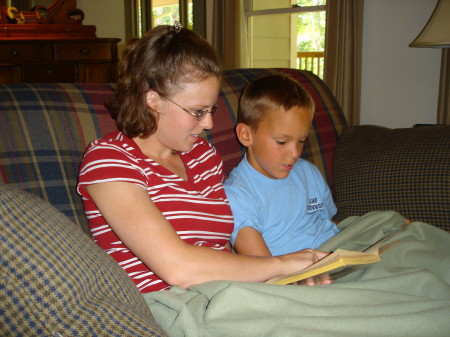Group homes get some pretty bad press. And with good reason. The most recent article I’ve seen was this one that outlines the problems in group homes and talks about how many states are seeking to phase them out entirely. As a former houseparent in a “group home” I can feel a little defensive when I read these pieces.
The facility where we worked did not like to use the term “group home” to describe what they did specifically because of the negative associations people have. And it was not your traditional group home by any means. We preferred to say “residential boarding school” because that was a bit more accurate. We provided an on campus school and kids lived in home environments with a family-type structure. It was not like a dorm or like a prison ward. Just a big, beautiful house where unrelated kids came to live because they found themselves in need of a safe environment through no fault of their own. So while our experience isn’t necessarily typical of group homes in general, I still feel like those who are calling for all group homes to be phased out may not understand the specific population that is served by the group home environment.
In an ideal world, all children would be raised in families. In fact, they would be raised by their own, biological, intact family. We do not live in an ideal world. There are children who cannot live safely in their own families. In that case, we want to provide them with a safe temporary family until they can have permanency— either through reunification with their biological family or adoption. But what about the kids who cannot live safely in your typical foster family? The ideal may not be available to them and that’s when we need to start talking about the reality.
It is a bit of an adoption catchphrase to say, “Every child deserves a family.” It’s a lovely idea. And in theory, every child DOES deserve a family. The problem is that some kids were born into families who hurt them. They are going to suffer from those hurts and because of that abuse/neglect or because of their own unique needs (particularly mental health issues or behavioral problems) they are going to have a very difficult time finding a family that can meet their needs. The family that decides to take on those children will need to have a home specifically set up to ensure that child’s safety and the safety of everyone else in the home. They will need to have lots of support services in place. They will need special training. And even then, so much of it comes down to the child’s attitude about being in a family environment.
I think it’s naive to assume that if we just put kids in a nice family, they will acclimate and be fine. Many great families have been devastated by this mistaken belief. Many kids have been bounced from home to home because they were placed in an environment that couldn’t meet their needs. This makes it even more difficult for them to trust or bond if they are eventually offered permanency. So while every child does “deserve” a family, sometimes kids have been wounded enough or have enough problems of their own that finding a family that can meet their needs becomes difficult if not impossible. There are simply not enough qualified foster families who are able to devote the attention required to helping these kids get the help they need. I want to see more foster families volunteer for this, but I’m not sure we will ever have enough to meet this need, especially if a child also requires a home that is specially equipped to keep them safe or to keep others safe from them.
The group home we served in was a “least restrictive environment.” We didn’t take kids who needed to be restrained or who had juvenile records or substance abuse problems or were on heavy meds. Those kids needed a different level of supervision, accountability, and therapy than we could provide. So even in a place where we had strict safety procedures, trained staff, therapists on campus, and a house equipped to ensure safety, there were kids who could not safely live with us and had to go to a more restrictive environment. It was heartbreaking to us when that happened, especially since we could see the consequences in ways the kids couldn’t. We knew they were going to lose freedoms and have a harder time integrating back into their families if they had to go to a different kind of facility. But sometimes that was what we had to recommend because of the issues of the children involved.
So I’m just not sure you can ever fully eliminate the need for group homes. And I think the solution to many of the problems the article I mentioned above presents are to hire better quality staff. It may be difficult to find 8 foster families that are capable of handling 8 troubled kids, but it may be possible to find one professional foster family that can handle 8 troubled kids in a well-equipped environment with the right support. It will be difficult to find quality houseparents in a group home setting when we continue to denigrate the work they do and imply that those facilities are hotbeds of sexual or physical abuse. If we don’t treat that profession with respect, then we can’t expect respectable people are going to apply for the job.
Obviously group homes can be problematic. Nobody can deny the statistics. But I think problems happens when we develop a mentality that these are throw away kids. When we believe these are kids that can’t be helped and that nobody wants. Instead, we have to realize that these are kids who have unique needs that should be respected and addressed. Just because they may not easily fit in a traditional family environment doesn’t mean they don’t need love, security and affection. A group home doesn’t have to mean we give up on these kids creating meaningful connections or eventually learning the skills and trust necessary to rejoin a family or least interact successfully with peers, in school, at their jobs. A group home shouldn’t just be a holding facility until kids are released into the adult world.
When Brian and I decided to pursue houseparenting it was because we felt there wasn’t another way for us to do the kind of good we wanted to do. I was working in a special education classroom that served a lot of children with behavioral problems. These kids came from some very difficult homes. Brian worked at the Boys and Girls Club where he ended up serving a lot of the same children I was during the school day. Between the two of us we had these kids from 8 a.m. to 6 p.m. and it still wasn’t enough to counter the negative influences that were happening in their homes. We wanted to do more.
We loved our years as houseparents. It wasn’t just a job, it was a calling. We built great relationships with our boys and and their families. We did our best to create a family feel for our boys and also to help them have positive relationships with their families back home. When handled correctly by people with a passion, I think it’s possible to create a positive experience for kids in a group home environment.
But it has to be the right kind of kids. Kids that need this as their best option. (This article is a great read on the potential positives of a group home run well and targeted to the right population.)
I do feel like there was a specific subgroup of children that we failed in our group home years. Their faces haunt me and they are one of the reasons we haven’t continued to pursue group home work. These kids are the reason I think the call to reevaluate who we place in group homes has merit.
Tomorrow’s post will detail what kids I’m talking about and why I think their needs can’t be met in a group home.

